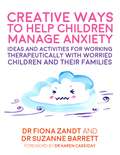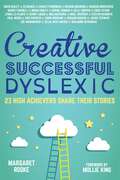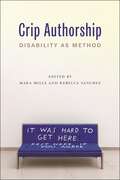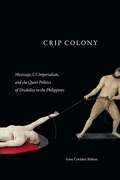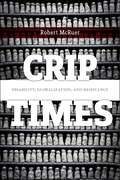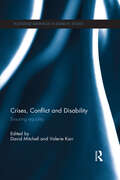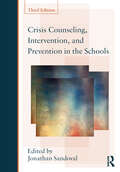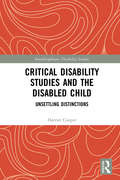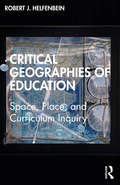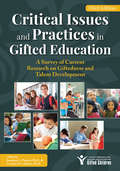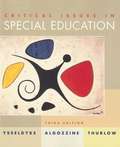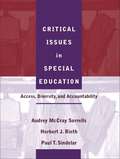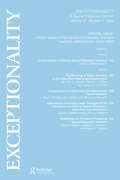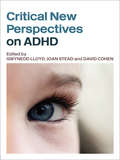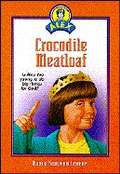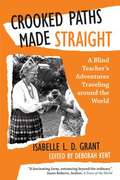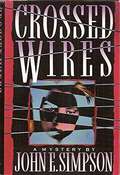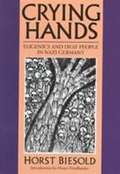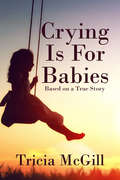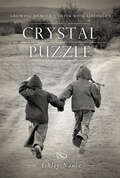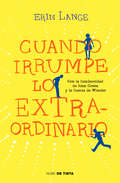- Table View
- List View
Creative Ways to Help Children Manage Anxiety: Ideas and Activities for Working Therapeutically with Worried Children and Their Families
by Fiona Zandt Suzanne BarrettThis book sets out therapeutic activities to help children aged 4-12 years and their families to better understand and manage anxiety. It explains how to work with anxious children, providing a framework for assessment and therapy that draws on CBT, ACT and narrative therapy approaches. Lots of practical tips for therapists are included and important developmental considerations are discussed, including adapting therapy for children with developmental difficulties, and working with families and schools.Over 50 playful therapeutic activities are included, which have been developed through the authors' extensive work with children, giving children an arsenal of coping strategies. They focus on key areas such as understanding anxiety, managing anxious thoughts, and building resilience and use readily available, inexpensive materials and downloadable templates which are provided in the book. This is the perfect tool for therapists looking for playful and purposeful ways to work with children with anxiety.
Creative, Successful, Dyslexic: 23 High Achievers Share Their Stories
by Richard Rogers Benjamin Zephaniah Charley Boorman Nigel Mccrery Paul Nixon Sir Richard Branson Kenny Logan Marcus Brigstocke Eddie Izzard Chris Robshaw Mollie King Meg Mathews Ed Baines Brian Conley Darcey Bussell Cbe Steven Naismith David Bailey Cbe Sir Jackie Obe Zoe Wanamaker Cbe Theo Paphitis Margaret Rooke Lynda La Cbe Sophie Conran Zelda West-Meads Kelly Hoppen Mbe23 very well-known people from the arts, sport, and business worlds talk about how dyslexia affected their childhood, how they were able to overcome the challenges and use the special strengths of dyslexia to achieve great success in adulthood. Darcey Bussell CBE, Eddie Izzard, Sir Richard Branson, Meg Mathews, Zoe Wanamaker CBE, Richard Rogers, Benjamin Zephaniah, Steven Naismith, Lynda La Plante CBE, Sir Jackie Stewart OBE, Sophie Conran and others share their stories, and their advice. All reveal the enormous difficulties they faced, the strength required to overcome them, the crucial importance of adult support, and how `the different way the brain is wired' in dyslexia has enabled them to see something different in the world and to use their creativity in an exceptional way. They talk about `thinking sideways', and the ability to look at a bigger picture, the often strong visual strength, and the ability to listen, and to grasp simplicity where other people see only complexity. They also talk about how dyslexia continues to challenge them, and the ways they have found to work around this. An introduction, and final section that includes practical information about dyslexia, are written with the support of Dyslexia Action, and a percentage of profit from the book is donated to Dyslexia Action. The book will be essential reading for teachers and other professionals, and for families affected by dyslexia, and inspirational for people with dyslexia.
Crip Authorship: Disability as Method
by Mara Mills and Rebecca Sanchez2024 Daniel E. Griffiths Research Award Winner2024 Outstanding Academic Title, given by Choice ReviewsAn expansive volume presenting crip approaches to writing, research, and publishing. Crip Authorship: Disability as Method is an expansive volume presenting the multidisciplinary methods brought into being by disability studies and activism. Mara Mills and Rebecca Sanchez have convened leading scholars, artists, and activists to explore the ways disability shapes authorship, transforming cultural production, aesthetics, and media.Starting from the premise that disability is plural and authorship spans composition, affect, and publishing, this collection of thirty-five compact essays asks how knowledge about disability is produced and shared in disability studies. Disability alters, generates, and dismantles method. Crip authorship takes place within and beyond the commodity version of authorship, in books, on social media, and in creative works that will never be published. The chapters draw on the expertise of international researchers and activists in the humanities, social sciences, education, arts, and design. Across five sections—Writing, Research, Genre/Form, Publishing, Media—contributors consider disability as method for creative work: practices of writing and other forms of composition; research methods and collaboration; crip aesthetics; media formats and hacks; and the capital, access, legal standing, and care networks required to publish. Designed to be accessible and engaging for students, Crip Authorship also provides theoretically sophisticated arguments in a condensed form that will make the text a key resource for disability studies scholars. Essays include Mel Y Chen on the temporality of writing with chronic illness; Remi Yergeau on perseveration; La Marr Jurelle Bruce on mad Black writing; Alison Kafer on the reliance of the manifesto genre on disability; Jaipreet Virdi on public scholarship for disability justice; Ellen Samuels on the importance of disability and illness to autotheory; Xuan Thuy Nguyen on decolonial research methods for disability studies; Emily Lim Rogers on virtual ethnography; Cameron Awkward-Rich on depression and trans reading methods; Robert McRuer on crip theory in translation; Kelsie Acton on plain language writing; and Georgina Kleege on description as an access and aesthetic technique.
Crip Colony: Mestizaje, US Imperialism, and the Queer Politics of Disability in the Philippines
by Sony Coráñez BoltonIn Crip Colony, Sony Coráñez Bolton examines the racial politics of disability, mestizaje, and sexuality in the Philippines. Drawing on literature, poetry, colonial records, political essays, travel narratives, and visual culture, Coráñez Bolton traces how disability politics colluded with notions of Philippine mestizaje. He demonstrates that Filipino mestizo writers in the late nineteenth and early twentieth centuries used mestizaje as a racial ideology of ability that marked Indigenous inhabitants of the Philippines as lacking in civilization and in need of uplift and rehabilitation. Heteronormative, able-bodied, and able-minded mixed-race Filipinos offered a model and path for assimilation into the US empire. In this way, mestizaje allowed for supposedly superior mixed-race subjects to govern the archipelago in collusion with American imperialism. By bringing disability studies together with studies of colonialism and queer-of-color critique, Coráñez Bolton extends theorizations of mestizaje beyond the United States and Latin America while considering how Filipinx and Filipinx American thought fundamentally enhances understandings of the colonial body and the racial histories of disability.
Crip Times: Disability, Globalization, and Resistance (Crip #1)
by Robert McRuerContends that disability is a central but misunderstood element of global austerity politics. Broadly attentive to the political and economic shifts of the last several decades, Robert McRuer asks how disability activists, artists and social movements generate change and resist the dominant forms of globalization in an age of austerity, or “crip times.” Throughout Crip Times, McRuer considers how transnational queer disability theory and culture—activism, blogs, art, photography, literature, and performance—provide important and generative sites for both contesting austerity politics and imagining alternatives. The book engages various cultural flashpoints, including the spectacle surrounding the London 2012 Olympic and Paralympic Games; the murder trial of South African Paralympian Oscar Pistorius; the photography of Brazilian artist Livia Radwanski which documents the gentrification of Colonia Roma in Mexico City; the defiance of Chilean students demanding a free and accessible education for all; the sculpture and performance of UK artist Liz Crow; and the problematic rhetoric of “aspiration” dependent upon both able-bodied and disabled figurations that emerged in Thatcher’s England. Crip Times asserts that disabled people themselves are demanding that disability be central to our understanding of political economy and uneven development and suggests that, in some locations, their demand for disability justice is starting to register. Ultimately, McRuer argues that a politics of austerity will always generate the compulsion to fortify borders and to separate a narrowly defined “us” in need of protection from “them.”
Crises, Conflict and Disability: Ensuring Equality (Routledge Advances in Disability Studies)
by David Mitchell Valerie KarrPeople with disabilities are among the most adversely affected during conflict situations or when natural disasters strike. They experience higher mortality rates, have fewer available resources and less access to help, especially in refugee camps, as well as in post-disaster environments. Already subject to severe discrimination in many societies, people with disabilities are often overlooked during emergency evacuation, relief, recovery and rebuilding efforts. Countries party to the UN Convention on the Rights of Persons with Disabilities must take all necessary measures to ensure the protection and safety of people with disabilities during situations of armed conflict, humanitarian emergencies, and natural disasters. Such aid should be designed to support preparedness, response, recovery and rebuilding. This book includes perspectives from around the globe and explores the implications at the policy, programme, and personal level, discussing issues such as: How can national laws, policies, and regulations provide guidance, methods and strategies to integrate and coordinate inclusive emergency management? What should people with disabilities know in order to be prepared for emergency situations? What lessons have we learned from past experiences? What are the current shortfalls (physical and cultural) that put people with disabilities at risk during emergencies and what can be done to improve these situations (e.g. through new technologies and disaster planning)? How does disability affect people’s experiences as refugees and other displaced situations; what programmes and best practices are in place to protect and promote their rights during their period of displacement? How must disabled people with disabilities be factored in to the resettlement and rebuilding process; does an opportunity for ensuring universal access exist in the rebuilding process? What is the impact of disasters and conflicts on such special populations as disabled women, disabled children, and those with intellectual disabilities? Spotlighting a pressing issue that has long been neglected in emergency planning fields, this innovative book discusses how to meet the needs of people with disabilities in crises and conflict situations. It is an important reference for all those working in or researching disability and inclusion, and emergency and disaster management, both in developed and developing countries.
Crisis Counseling, Intervention and Prevention in the Schools (Consultation, Supervision, and Professional Learning in School Psychology Series)
by Jonathan SandovalSince the first edition was published in 1988, the role of crisis intervention and prevention has become central to mental health professionals working in the schools. Disasters such as hurricane Katrina, terrorist attacks both in this country and around the world, and various school shootings have greatly increased school crisis research and policy development. This book is designed for an introductory graduate course taken by students in school psychology, school counseling, and school social work. Section I provides a crisis response overview, section II deals with crises for children and adolescents and section III covers crises that manifest in adolescence. Discussions of the 16 most prevalent types of crises are covered in sections II and III and include their characteristics, causes, interventions, and preventive programs. All chapters will be updated, six heavily revised or totally rewritten by new authors, and two new chapters (chapters 8 & 19) have been added.
Critical Disability Studies and the Disabled Child: Unsettling Distinctions (Interdisciplinary Disability Studies)
by Harriet CooperThis book examines the relationship between contemporary cultural representations of disabled children on the one hand, and disability as a personal experience of internalised oppression on the other. In focalising this debate through an exploration of the politically and emotionally charged figure of the disabled child, Harriet Cooper raises questions both about what it means to ‘speak for’ the other and about what resistance means when one is unknowingly invested in one’s own abjection. Drawing on both the author’s personal experience of growing up with a physical impairment and on a range of critical theories and cultural objects – from Frances Hodgson Burnett’s novel The Secret Garden to Judith Butler’s work on injurious speech – the book theorises the making of disabled and ‘rehabilitated’ subjectivities. With a conceptual framework informed by both psychoanalysis and critical disability studies, it investigates the ways in which cultural anxieties about disability come to be embodied and lived by the disabled child. Posing new questions for disability studies and for identity politics about the relationships between lived experiences, cultural representations and dominant discourses – and demonstrating a new approach to the concept of ‘internalised oppression’ – this book will be of interest to scholars and students of disability studies, medical humanities, sociology and psychosocial studies, as well as to those with an interest in identity politics more generally.
Critical Geographies of Education: Space, Place, and Curriculum Inquiry
by Robert J. HelfenbeinWINNER 2023 Society of Professors of Education Outstanding Book AwardCritical Geographies of Education: Space, Place, and Curriculum Inquiry is an attempt to take space seriously in thinking about school, schooling, and the place of education in larger society. In recent years spatial terms have emerged and proliferated in academic circles, finding application in several disciplines extending beyond formal geography. Critical Geography, a reconceptualization of the field of geography rather than a new discipline itself, has been theoretically considered and practically applied in many other disciplines, mostly represented by what is collectively called social theory (i.e., anthropology, sociology, cultural studies, political science, and literature). The goal of this volume is to explore how the application of the ideas and practices of Critical Geography to educational theory in general and curriculum theorizing in specific might point to new trajectories for analysis and inquiry. This volume provides a grounding introduction to the field of Critical Geography, making connections to the significant implications it has for education, and by providing illustrations of its application to specific educational situations (i.e., schools, classrooms, and communities). Presented as an intellectual geography that traces how spatial analysis can be useful in curriculum theorizing, social foundations of education, and educational research, the book surveys a range of issues including social justice and racial equity in schools, educational reform, internationalization of the curriculum, and how schools are placed within the larger social fabric.
Critical Issues and Practices in Gifted Education: A Survey of Current Research on Giftedness and Talent Development
by Ph. D. And Carolyn M. Callahan Jonat PluckerCritical Issues and Practices in Gifted Education is the definitive reference for a summary and evaluation of the literature on giftedness, gifted education, and talent development. This third edition:Presents more than 40 summaries of important topics in the field.Features updates to all topics.Introduces new topics, including neuroscience and the roles of leaders in the field.Dives into the latest research.Explores how the research applies to gifted education and the lives of gifted learners.This book also provides an objective assessment of the available knowledge on each topic, offers guidance in the application of the research, and suggests areas of needed research.
Critical Issues in Special Education, Third Edition
by Martha L. Thurlow Bob Algozzine James E. YsseldykeCritical Issues in Special Education is an analysis of important conceptual and practical issues that face special education professionals. Part One illustrates the background and status of special education through current analysis of fundamental guiding practices. Part Two focuses on key practices in special education services. Part Three provides an analysis of social, political, legal, and economic activity reflected in special education practice.
Critical Issues in Special Education: Access, Diversity, and Accountability
by Audrey Mccray Sorrells Herbert J. Rieth Paul T. SindelarThis textbook provides synopses of current issues deemed critical in the field of special education as outlined by the most prolific authors.
Critical Issues in Training Special Education Teachers: A Special Issue of exceptionality
by Laurie U. DeBettencourtFirst Published in 2005. Routledge is an imprint of Taylor & Francis, an informa company.
Critical New Perspectives on ADHD
by Gwynedd LloydExperts from all over the world take a critical, highly international and often controversial perspective on the ADHD phenomenon – a condition that has reached global proportions, significantly affecting the lives of children, parents and teachers worldwide. This book raises a number of concerns often not covered by the material currently available to parents and practitioners. Critical New Perspectives on ADHD unpicks the myths surrounding the development of this phenomenon and leaves no stone unturned in its search for answers. An in-depth exploration into the reasons for the emergence and maintenance of ADHD lead to suggested explanations of the dominance of US psychiatric models and the need for new markets for major pharmaceutical companies, as well as the functions that ADHD diagnoses fulfil in families, classrooms and communities. In a world where moves to educational inclusion are paradoxically paralleled by the ever-increasing use of medication to control children’s behaviour, this book scrutinises current accepted practice and offers alternative perspectives and strategies for teachers and other education professionals. This in an invaluable resource for anyone with a serious interest in ADHD and other behavioural difficulties.
Crocodile Meatloaf
by Nancy Simpson LeveneAs she becomes friends with Rachel, a deaf girl who has joined her sixth-grade class, Alex begins to feel that God has given her a mission to protect Rachel from the boy who is tormenting her.
Crocodiles Can't Climb Trees: Targeting the k Sound (Speech Bubbles 1)
by Melissa PalmerLucas the Monkey loves to play soccer by the river, but he has a problem – Mr. Crocodile, who would love to make Lucas his dinner. This picture book targets the /k/ sound, and is part of Speech Bubbles 1, a series of picture books that target specific speech sounds within the story. The series can be used for children receiving speech therapy, for children who have a speech sound delay/disorder, or simply as an activity for children’s speech sound development and/or phonological awareness. They are ideal for use by parents, teachers or caregivers. Bright pictures and a fun story create an engaging activity perfect for sound awareness. Please see other titles in the series for stories targeting other speech sounds.
Crooked Paths Made Straight: A Blind Teacher's Adventures Traveling Around The World
by Deborah Kent Isabelle L. D. Grant<P>In 1959, two years before she retired from teaching, Dr. Isabelle Grant set off on a yearlong journey around the world with Oscar, her long white cane, in her hand. She had been totally blind for the past twelve years. <P>In Crooked Paths Made Straight, she shares the story of her journey during which she visited twenty-three countries from Great Britain to Fiji. In Karachi, she traveled the streets by rickshaw and struggled to master the Urdu language. In India, she explored the Taj Mahal, and in Burma she slept in a room where lizards raced up and down the walls. <P>At a time when both women and blind people were generally seen as too helpless for solo travel, Grant fearlessly defied conventions. A dedicated teacher with a lifelong commitment to learning, her mission was to learn all she could about education in the countries she visited, in particular the education provided to blind children. <P>Completed in 1965, Crooked Paths Made Straight recounts Grant's journey, a story of dreams deferred that did not shrivel but sprang to life again and again.
Cross-Cultural Psychotherapy: Toward a Critical Understanding of Diverse Clients
by Charles NegyTable of Contents Part I: Conceptual and Practical Considerations for Effective Therapy 1. Treating Dissimilar Clients: No Longer the Road Less Traveled 1 Charles Negy 2. Competencies for Providing Services to Dissimilar Clients 23 Anthony F Greene 3. Cross-Cultural Assessment: Conceptual Framework and Guiding 35 Principles Lisa A. P. Sanchez-Johnsen and Israel Cuellar 4. Religious Bigotry in Multicultural Psychology and Therapy 61 Charles Negy and Christopher J. Ferguson Part II: Racial and Ethnic Populations 5. Introduction to Hispanic Americans and Latinos/as 77 Miguel Angel Cano and Flor Vanessa Perez 6. Mexican American Psychology: Theory and Clinical Application 85 Linda G. Castillo and Miguel A. Cano 7. Psychological Issues with Puerto Ricans: A Review of Research Findings 103 Consuelo Arbona and Baisilisa Virella 8. Immigration History and Therapy Considerations with Hispanics from Cuba, Central and South America 133 Edward Anthony Delgado-Romero, Angela Rojas-Vilches, and Kimber L. Shelton 9. African American Clients: History and Therapy Considerations 161 Nique Fajors and Charles Negy 10. Caucasian (White) Americans: The Forging of an Identity and Culture 187 Christopher Aaron Myers, Dawna Cricket Martita Meehan, and Charles Negy 11. Assessment and Psychotherapy with Asian Americans 207 Eddie Yu-Wai Chiu 12. Cultural Bereavement and Sense of Coherence: Implications for Psychotherapy with Southeast Asian Refugees 237 Eddie Yu-Wai Chiu 13. Psychotherapy with Asian Indian Immigrants: Evolving Issues 251 and Concerns Vidyulata Kamath, Benjamin A. Orooji, and Christopher J. Ferguson 14. Multiracial/ethnic Clients: History, Models, and Treatment Implications 269 Charles Negy, Jenny L Klein, and Eva D. C. Brantley 15. Therapy with Native American Clients 289 Charles Negy 16. Mental Health Counseling with Arab Americans 309 Christopher J. Ferguson PART III: Other Culturally Diverse Populations 17. Feminist Therapies: Working with Diverse Women 327 Shelley M. Park 18. Affirmative Counseling and Psychotherapy with Lesbian, Gay, Bisexual, and Transgender Clients 363 Dean M. Amadio and Ruperto M. Perez 19. Working with Disabilities: Client, Therapist, Treatment, and Family Variables 401 Cliff McKinney 20. Older Adults: The Emerging Population for the 21st Century 413 Andrea Dixon Rayle
Crossed Wires
by John E. Simpson<P>Crossed Wires, a highly original mystery novel, introduces readers to an unusual heroine, who is being stalked by a particularly chilling serial killer. Finley is tenacious, sympathetic, and attractive. What then makes her an unusual sleuth? Finley is deaf. And Finley and the murderer who hunts her inhabit, literally, a new world -almost a new dimension. They live an important part of their lives within the electronic bulletin boards accessed by their personal computers. <P>Finley, whose hearing impairment makes her vulnerable, has learned to live and rely upon faceless friends, especially Tracy and Jane, she knows only through her modem. She works as a researcher at CIAC, the National Crime Information and Analysis Center in New Brunswick, New Jersey, a very sophisticated clearing house for law enforcement agencies. Even without romance, life is pretty good for Finley, with a challenging job as an electronic detective and an apparently reliable set of friends, until one beautiful fall morning the ebullient Tracy is murdered - her throat slashed and her computer's memory wiped clean.
Cry Rape: The True Story of One Woman's Harrowing Quest for Justice
by Bill LuedersCry Rape dramatically exposes the criminal justice system’s capacity for error as it recounts one woman’s courageous battle in the face of adversity. In September 1997, a visually impaired woman named Patty was raped by an intruder in her home in Madison, Wisconsin. The rookie detective assigned to her case came to doubt Patty’s account and focused the investigation on her. Under pressure, he got her to recant, then had her charged with falsely reporting a crime. The charges were eventually dropped, but Patty continued to demand justice, filing complaints and a federal lawsuit against the police. All were rebuffed. But later, as the result of her perseverance, a startling discovery was made. Even then, Patty’s ordeal was far from over. Other books have dealt with how police and prosecutors bend and break the law in their zeal to prevail. This one focuses instead on how the gravest injustice can be committed with the best of intentions, and how one woman’s bravery and persistence finally triumphed.
Crying Hands: Eugenics and Deaf People in Nazi Germany
by Horst Biesold Williams SayersExposes the active collusion with the Nazis of various physicians, administrators, and teachers of the deaf who embraced the Third Reich's eugenics policies. Documents the collusion of deaf leaders, who tried to incorporate all independent deaf groups into one Nazi organization while expelling deaf Jews, and traces resistance against the Third Reich by deaf Germans. Includes personal accounts of some of the 1,215 deaf victims of enforced sterilization, demonstrating the lasting physical and emotional pain of Nazi violations. The author is a retired professor and teacher of deaf students.
Crying is for Babies: Based on a True Story
by Tricia McGillIn the 1930s medicine was still very much a hit and miss affair. The surgeons were still experimenting and learning about the human body. This at a period when there was little in the way of pain relief. This is one woman’s story about a childhood ruined by such surgeons, whose bad judgement confined an eight-year-old subsequently to bed for three years and left her with a disability to last a lifetime. Nowadays she would have been given bed rest and pain relief, and in no time would have been up and running again. Her strong will, and the love of a close family, saw her through the bad times, enabling her to go on and become the talented, remarkable person she was. I know because this woman was my sister.
Crystal Puzzle: Growing Up with a Sister with Asperger's
by Ashley NanceA delightful and true story of growing up with a sister with Asperger's Syndrome, The Crystal Puzzle chronicles powerful family experiences from the realization that there was something different about her sister through the hopes and joys and challenges of school to the eventual independence that comes with growing apart as one sister moves on and out of the home. Blogger Ashley Nance offers an accurate, humorous, touching, and poignant glimpse into the lives of those affected by Asperger's and learning disabilities.Crystal Puzzle also includes a helpful resource section for families interested in additional information to help them cope and succeed given the challenges that come with Asperger's and other learning disabilities.
Cuando irrumpe lo extraordinario
by Erin LangeUna conmovedora y luminosa novela sobre la poco probable y, aun así, inquebrantable amistad entre un matón de instituto y un chico con síndrome de Down Una adivinanza no tiene sentido la primera vez que la oyes. La amistad entre Dane y Billy D. tampoco: ¿qué tienen en común el matón del instituto y un chico con síndrome de Down? En el caso de Billy y Dane, tienen un mismo problema: Dane no sabe quién es su padre, y Billy está decidido a reencontrarse con el suyo. Su amistad puede llevarlos a descubrir la verdad... ¿pero qué descubrirán sobre sí mismos? Enternecedora y lúcida, Cuando irrumpe lo extraordinario es una inolvidable historia sobre las segundas oportunidades, la amistad y el amor: una celebración de las personas y sucesos impensados que dan un vuelco a nuestras vidas. La crítica ha dicho... «La historia de dos personajes imperfectos y memorables.» Booklist «Dane no es unhéroe ni Billy D. una víctima inocente: Lange es demasiado buena como para eso. Ambos chicos son personas de carne y hueso con la capacidad de divertir, encandilar y enfurecer al lector, cuyas emociones oscilan deliciosamente entre la adoración y las ganas de chocarles la cabeza de uno contra la del otro de pura exasperación.» The Guardian
Cultivating diversity and inclusion: using global and multicultural children's literature in grades K-5, Second Edition
by Paula Saine"Cultivating Diversity and Inclusion: Using Global and Multicultural Children's Literature in Grades K-5 offers children's books from across the world that engages students with cultural language experiences and provides ways to incorporate apps and social media activities in the classroom"--Provided by publisher.
